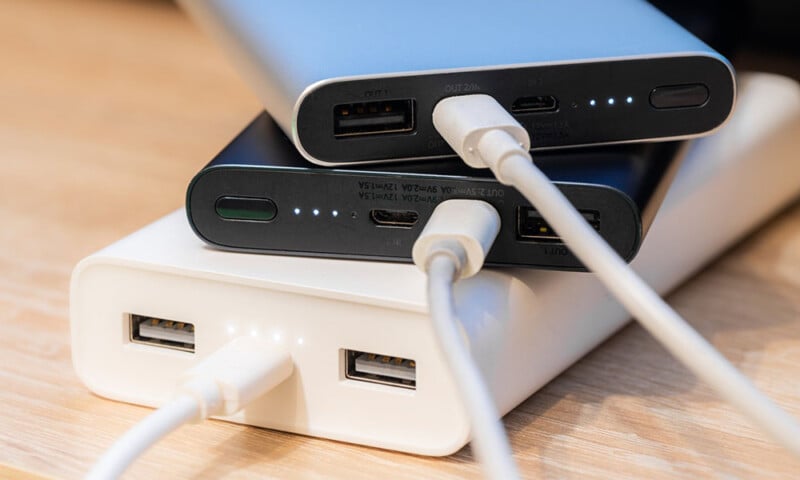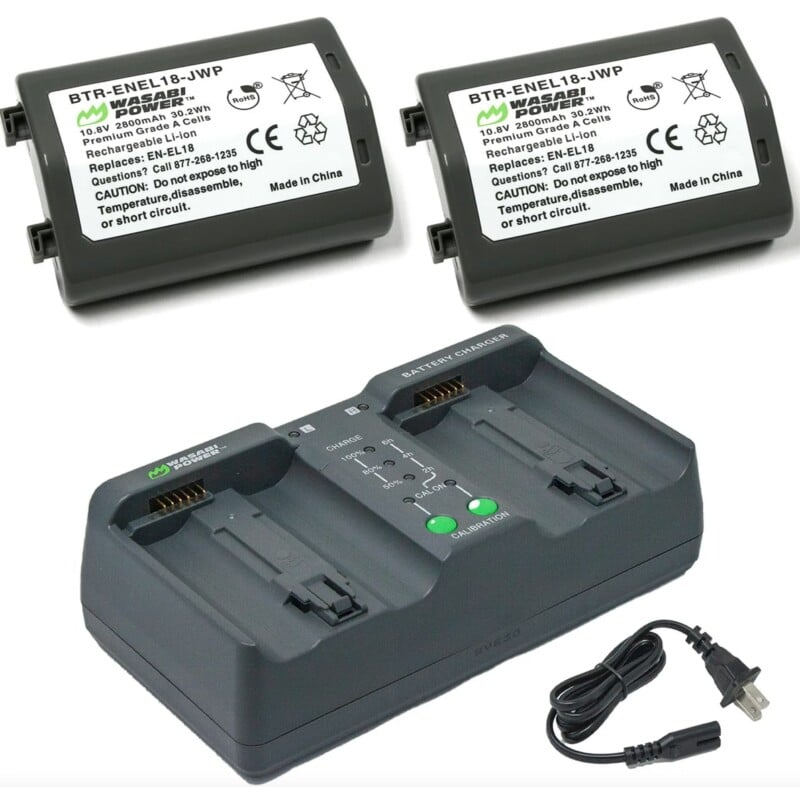As many of us, including myself, prepare to travel this summer, we — as photographers — tend to carry a lot of lithium batteries for our photography gear. After all, we aren’t going to check our precious and pricey cameras, lenses, and other equipment. Naturally, batteries are a necessary component of any photographer’s kit, whether they be camera batteries, lithium-ion AA or AAA batteries, or something else.
Traveling with lithium batteries has become commonplace as they power everything from smartphones to laptops, cameras, and even medical devices. In May 2023, the Federal Aviation Administration (FAA) revealed that lithium-ion battery fires had jumped 42 percent in the last five years. So far this year, nineteen lithium battery incidents have occurred.
This video is a good example of what can happen when proper protocols aren’t followed.
Given their ubiquitous presence in our everyday gadgets, understanding the regulations for carrying lithium batteries on airplanes is crucial to avoid being a part of statistics like that and ensure compliance with FAA requirements. So, we decided to put together a guide about flying with batteries — specifically, the rules and regulations set by the FAA and the Transportation Security Administration (TSA) around batteries and how to pack and transport them safely to adhere to those requirements.
Note: This guide primarily focuses on flying within the United States. Different countries have varying regulations, and you should check those before flying if you don’t live in the United States or are flying internationally.
Table of Contents
The Risks of Lithium Batteries in Air Travel
![]()
Lithium batteries are integral to many of the devices we rely on daily, from smartphones and laptops to cameras and other personal electronics. As travelers, we often bring these devices along on flights without a second thought. However, due to the inherent risks associated with these batteries, specific regulations are in place to ensure air travel safety.
Lithium batteries are favored by manufacturers for their high energy density, which allows them to last longer than other batteries of similar size. However, this energy density also brings risks, particularly the risk of thermal runaway. In short, thermal runaway occurs when a battery becomes overheated, leading to a chemical reaction that causes it to ignite or explode. This reaction can be triggered by physical damage, short-circuiting, or exposure to extreme temperatures, among other potential factors.
![]()
In the confined space of an aircraft, a thermal runaway event can be especially dangerous. A fire in the cabin or cargo hold can be difficult to control and may lead to catastrophic consequences. Recognizing these dangers, aviation authorities worldwide have established stringent guidelines for transporting lithium batteries on aircraft.
U.S. Regulations for Lithium Batteries on Planes
In the United States, the Transportation Security Administration (TSA) and the Federal Aviation Administration (FAA) are the primary agencies responsible for setting and enforcing rules regarding the air transport of lithium batteries.
![]()
Here are the key guidelines set by the TSA and FAA:
Personal Electronic Devices: Devices containing lithium-ion batteries (like phones, laptops, tablets, and cameras) should ideally be carried in hand luggage. If these must be placed in checked baggage, the devices should be completely powered off (not in sleep or hibernation mode) and must be protected from accidental activation and damage. The FAA, however, highly recommends packing them in carry-on whenever possible, as flight crews can better monitor conditions and have much easier access if a fire occurs.
Spare Batteries: Spare lithium batteries are only allowed in carry-on baggage. They must be protected from short circuits by placing them in their original retail packaging or by taping over the terminals. It is also recommended that each battery be placed in a separate plastic bag or protective pouch. Spare dry cell alkaline or Nickel Metal Hydride (NiMH) or Nickel Cadmium (NiCad) batteries — such as AA, AAA, C, D, button cell, 9 volt, etc. can be placed in checked luggage, though the FAA urges flyers to pack them in their carry-on if possible.
Battery Chargers and Power Banks: You can pack battery chargers in carry-on or checked luggage. Do not pack non-rechargeable batteries in a battery charger — they are not designed for charging, which can be hazardous. You can pack rechargeable batteries in a charger, but if they are lithium batteries, they cannot go in checked bags. Power banks are allowed in carry-on luggage only as they are considered spare batteries by the FAA. Additionally, most power banks are under the 100Wh limit.
Battery Capacity Limits: Lithium-ion batteries installed in personal electronic devices can be carried without specific approval if they contain no more than 100 watt-hours (Wh) per battery. This covers most any batteries that almost all photographers carry, but videographers may have higher-capacity batteries. In such a case, batteries with a capacity of 100 Wh to 160 Wh can be carried with airline approval, typically limited to two spare batteries per person.
![]()
These rules are strictly enforced during security screenings, and non-compliance can result in fines or even criminal charges, depending on the severity of the violation.
International Regulations and Variations
While the U.S. has its specific regulations, international guidelines can vary significantly, though many are based on standards set by the International Air Transport Association (IATA). These standards provide a framework that most international airlines follow, though each country may have additional rules or restrictions.
European Union: Like the U.S., the EU urges passengers to carry devices with lithium batteries in carry-on baggage. Batteries exceeding 100 Wh but not more than 160 Wh require airline approval.
Asia: Countries like Japan and South Korea are particularly strict about batteries in checked baggage and often have additional requirements for batteries carried on board, such as mandatory inspections at the airport. Please check your country’s requirements before flying.
Furthermore, travelers should always check the regulations of their airline as well as the departure and destination countries (if traveling internationally) to ensure compliance.
Packing Tips and Handling Lithium Batteries During Flights

Given the potential risks, properly packing and carrying lithium batteries is not just about compliance with regulations — it’s also a critical safety measure. Here are some tips to ensure that your lithium batteries are transported safely:
- Keep Batteries Accessible: When packing, keep your lithium batteries in a place where they can be easily accessed. This is important not only for security checks but also in case you need to respond to an issue with the battery during the flight.
- Protect from Damage: Ensure all devices and spare batteries are cushioned and protected from impact and puncture. Under the right conditions, even minor damage can escalate into a serious hazard.
- Avoid Temperature Extremes: Keep your electronic devices and batteries away from extreme temperatures, which can exacerbate the risks of lithium batteries. For example, don’t leave your laptop in a hot car before heading to the airport.
Proper packing is crucial when it comes to lithium batteries (as well as power banks), given their potential risks. Here are some steps to follow to ensure that your batteries are packed safely:
- Individual Protection: Each spare battery should be individually protected to prevent short circuits. This can be achieved by placing each battery in a separate plastic bag or a protective case (you can get nice cases that hold multiple batteries if you don’t already have one). If the terminals are not already protected by a case, make sure they are covered with tape.
- Use Original Packaging When Possible: If you still have the original packaging for your batteries and do not have a case, use it if you have the space. Original packaging is designed to be safe and protect the battery from any physical damage during transport.
- Avoid Contact with Metal: Ensure that batteries do not come into contact with anything metallic. This includes coins, keys, jewelry, and other loose items that could potentially bridge the terminals and create a short circuit.
- Carry On Essential Batteries Only: Only bring batteries that you will need during your trip. Not only does this reduce the weight and increase the available space inside your carry-on, but it minimizes the potential risk associated with carrying multiple high-energy lithium batteries.
Handling Lithium Batteries at the Airport and During Flight
Once you reach the airport and during your flight, handling your lithium batteries correctly continues to be important. Here are some guidelines to keep in mind:
- Security Checks: Be prepared to remove your batteries and devices from your carry-on during security checks. Keeping them easily accessible will help streamline this process. It is not common in my experience to have to remove average camera batteries or AA/AAA batteries, but I don’t fly very often, and every airport is different. Also, inform the TSA agent if you are carrying any batteries over 100Wh, as these may need special handling.
- In-Flight Usage: Use devices powered by lithium batteries responsibly. Keep them in sleep mode or turned off when not in use. If you must use a device during the flight, keep it at a moderate temperature and avoid placing it under heavy items that could cause damage.
- Immediate Action if Problems Arise: If you notice your device overheating, making unusual noises, or smelling odd, turn it off immediately. If it is a spare battery that is heating up, alert the cabin crew right away. They are trained to handle such situations and have access to specific fire-containment bags designed for electronic device fires.
Emergency Procedures for Battery Issues
Every airline is equipped to handle emergencies involving lithium batteries. Understanding these procedures can help you react appropriately:
- Containment: Flight attendants use fire containment bags specifically designed to withstand high temperatures. These bags can contain a device or battery until it burns out, preventing a fire from spreading.
- Evacuation: In extreme cases, where there is a risk of fire spreading or toxic fumes accumulating, the crew might initiate an emergency landing. Follow the crew’s instructions closely during such incidents.
- First Aid: If you or a fellow passenger is injured due to a battery malfunction, seek immediate assistance from the flight crew, who are trained in basic first aid and can help until professional medical help is available.

Traveling Safely with Lithium Batteries
Traveling with lithium batteries doesn’t have to be stressful. By understanding the risks, adhering to airline and TSA regulations, packing your batteries appropriately, and knowing how to handle them during your journey, you can ensure a safe and incident-free travel experience. Remember, the key to safe travel with lithium batteries lies in preparation and vigilance. Taking the necessary precautions and being aware of how to manage these devices in an emergency are essential steps for any traveler.
The following are resources that every photographer or videographer should double-check to ensure both compliance with regulations and safe travel for all passengers and crew.
